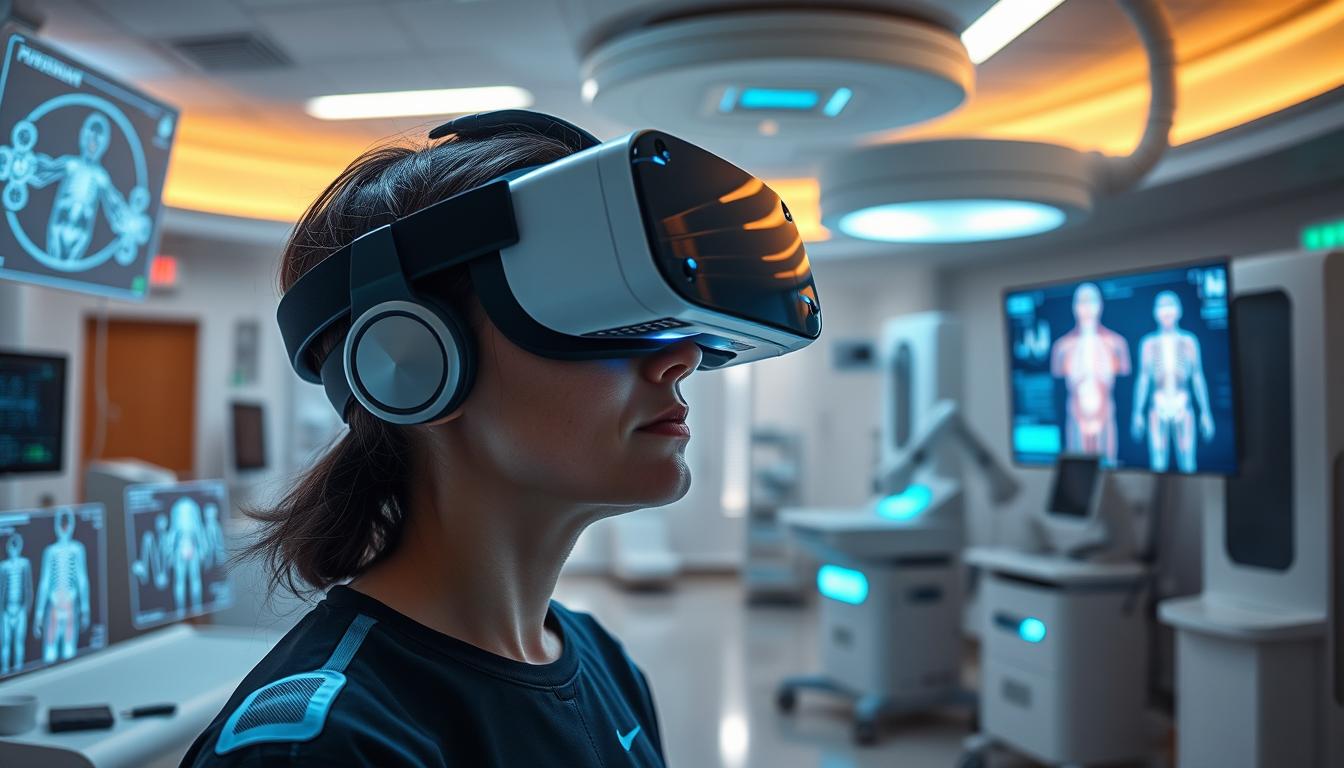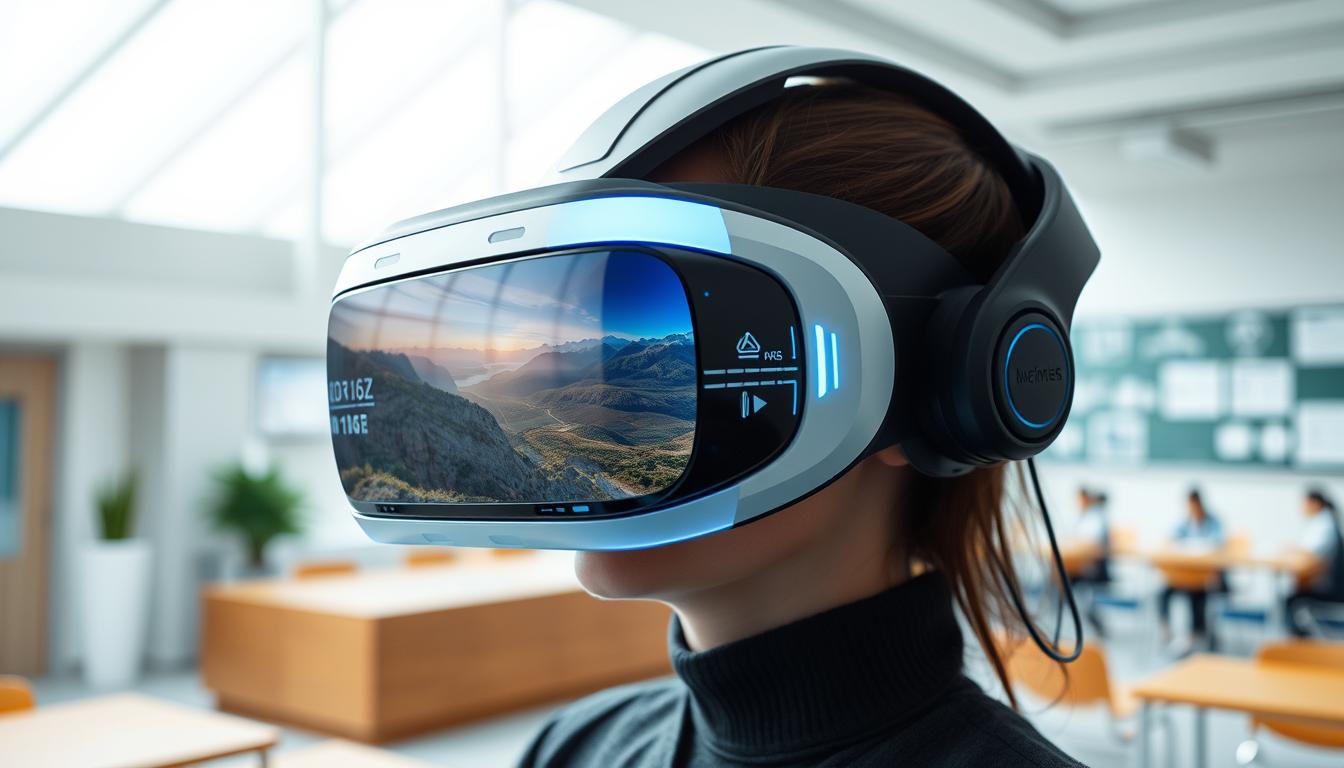I'm excited to see how virtual reality is changing healthcare and education. The global AR/VR market is expected to hit USD 165.2 Billion by 2032. This shows a big growth in this field. Virtual reality makes learning and patient care better with its interactive and immersive experiences.
VR technology is getting more use in healthcare, like managing pain and remote consultations. It's also changing education by making learning experiences interactive and reaching beyond borders. I'm looking forward to learning more about how VR can change these fields.
Exploring immersive technology, I'm amazed by VR and AR's wide uses. From virtual classrooms to surgical training, it offers new ways to teach and train. With VR, we can make learning personal and interactive, improving student engagement and memory.
The Current State of VR Technology
Exploring virtual reality, we see the latest tech advancements. High-resolution displays, advanced tracking, and immersive audio are key. These features make augmented reality a big part of VR.
The vr headset market is booming. Big names like Facebook, Google, and Microsoft are leading the charge. About 170 million people worldwide use VR, and the gaming market have hit $2.5 billion in 2023.
Top VR headset features include good image quality, comfort, and high-quality audio. Apple's Vision Pro headset, launched in 2024, brought new levels of quality and design.
The metaverse, introduced in 2021, is now a hot topic in 2025. Big brands like Meta, Microsoft, Disney, and Tencent are diving in. They're changing how we interact with digital content through VR and augmented reality.
Revolutionary Applications of VR in Modern Healthcare
Exploring virtual reality, I see its huge impact on healthcare. Vr applications are changing how we manage pain, train doctors, and teach patients about their health.
The benefits of vr applications in healthcare are clear:
- They help reduce anxiety and fear during medical procedures.
- They offer a non-drug way to manage pain.
- They make learning human anatomy easier with 3D models and photogrammetry.
A study with fifty patients showed VR can lower anxiety and fear during medical procedures. This was done without using medication. It shows VR's power in bettering patient care and results.
The range of vr applications in healthcare is huge. Researchers keep finding new ways to use VR to enhance medical training and patient care. As VR tech grows, we'll see even more creative uses in healthcare.
The Impact of Virtual Reality on Medical Training
Exploring medical training, I see how virtual reality (VR) is changing the game. VR gaming and virtual reality devices let students dive into real-life scenarios. This makes learning more interactive and immersive.
VR's big plus is it lets learners practice over and over. This is key in fields like surgery, where mistakes can be deadly. Studies show virtual reality devices like Oculus headsets help surgeons hone their skills safely.
Surgical Simulation and Practice
Take Johns Hopkins School of Nursing, for example. They use VR for training from doctoral to prelicensure levels. They focus on skills like resuscitation and acute-care management. Their VR scenarios can handle up to 100 learners, making it a great way to practice.
Anatomy Education Through VR
VR is also changing anatomy education. Medical students can explore the human body deeply with vr gaming and virtual reality devices. The University of Central Florida College of Nursing uses HoloLens and Oculus for interactive anatomy lessons.
Transforming Educational Paradigms Through VR
Exploring virtual reality (VR) in education shows its huge impact. It changes how we learn by making it more real and interactive. This makes learning more fun and memorable than old ways.
VR lets students experience things they can't in real life. They can explore history or visit far-off places. This helps them understand complex ideas better and appreciate them more. Personalized learning paths are also possible, letting students learn at their own speed and focus on what interests them.
VR in education has many benefits:
- Collaborative learning: students from anywhere can work together online
- Accessible education: it brings top-notch learning to those who can't get it easily
- Improved retention: VR helps students remember what they learn better than usual methods
As VR gets better and easier to use, it will be key for teachers. It offers a new way to learn that's fun, effective, and works for all ages.
Immersive Learning Experiences: Beyond Traditional Classrooms
Technology keeps getting better, making immersive learning more popular. Now, students can dive into interactive lessons with augmented reality and vr headset. These tools offer hands-on experiences that traditional classrooms can't match.
Immersive learning has many benefits. For instance:
- Students get more involved and participate more.
- They remember and understand complex ideas better.
- They learn to work together and solve problems.
Virtual field trips let students explore places like museums and historical sites from anywhere. They can get a feel for science and math through interactive lessons. Even language learning gets a boost with vr headset, making it easier to practice speaking and listening.
Recent numbers show 51% of companies use VR in their training in 2022. VR learners learn 4X faster than those in classrooms. Plus, VR learners feel 275% more confident in using their new skills.
Immersive learning is changing how we learn and interact with information. By using augmented reality and vr headset in schools, we can make learning more fun, interactive, and effective for everyone.
Overcoming Implementation Challenges in VR Integration
As vr experience changes many fields, like healthcare and education, we face big hurdles. One big issue is the high cost of VR gear and software. Many groups can't afford it. Also, we need more VR content and vr applications made just for VR.
Some main hurdles in using VR include:
- High initial investment costs
- Lack of customized content and applications
- Concerns about possible health issues, like eye strain and motion sickness
To beat these challenges, we must give users good training and support. This helps them get the most out of vr experience and vr applications. It's also key to handle user privacy and get their consent when using VR.
By tackling these issues and making top-notch vr applications, we can fully use VR's power. This way, we can offer users immersive, fun, and useful vr experience.
The Economic Impact of VR Adoption in Healthcare and Education
Exploring the economic impact of VR adoption, I see big benefits in healthcare and education. The global VR market size was USD 15.81 billion in 2020. It's expected to grow at 18.0% annually until 2028.
This growth will positively affect the economy. Estimated revenues range from $2.8 billion to $24.0 billion from 2016 to 2020. The economic impact of VR technology is huge, with a total economic value of $14.6 billion to $126.0 billion over five years.
VR gaming also plays a big role in this growth. The global VR gaming market size was USD 11.56 billion in 2020. It's expected to reach USD 42.50 billion by 2025.
Cost-Benefit Analysis
A cost-benefit analysis shows VR's benefits outweigh its costs in healthcare and education. For instance, VR training is cheaper than live training, costing $115.43 per participant. This is compared to $229.79 for live training.
Infrastructure Requirements
The infrastructure needed for VR technology is getting more affordable. This makes it easier for organizations to adopt VR and enjoy its benefits.
Return on Investment Projections
Return on investment projections for VR in healthcare and education are positive. Many organizations expect a significant return on their VR investment in the coming years. With the increasing demand for vr gaming and virtual reality devices, VR's future looks bright.
Conclusion: The Future Landscape of Virtual Reality in 2025
The future of virtual reality (VR) in 2025 looks exciting. New technologies will change how we see healthcare, education, and more. Companies like Apple, Google, Samsung, and Meta are leading this change with their advanced VR headsets.
These headsets will have high-definition displays and advanced sensors. They will also have haptic technologies that make experiences feel real. The designs will be light and comfortable, making it easy to use them for a long time.
Artificial intelligence (AI) will make VR even more personal. It will create dynamic environments and help more people create VR content. This will open up new possibilities in many areas.
VR will soon be used in healthcare, education, and even social events. As more people get VR headsets, the possibilities will grow. The future of VR is set to change how we live, learn, and connect with each other.











0 Comments